The Nottinghamshire Historian is produced twice a year and is included in the cost of membership of the Association. Every issue contains news, articles, book and periodical reviews.
Interested in writing for The Nottinghamshire Historian?
Contact our editor, SARAH SEATON at editor@nlha.org.uk, if you would like to discuss possible submissions and download a copy of our Guidelines for authors (pdf file) for advice on how we like articles to be submitted and the conventions we prefer.
Articles from issues 63 to 107
Number 107: Autumn/Winter 2021
A Day out in the Worksop Area– Sarah Seat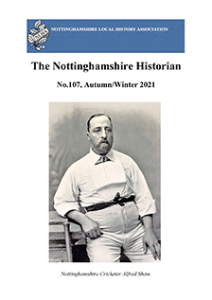 on
on
From a Pestilence Dell to Garden Plots where fairies dwell– Jeffrey Sheard
Since 1888– Neil Kendrick
Nottinghamshire Elopements– Adrian Gray
Number 106: Spring/Summer 2021
 A Day out in the Mansfield Area– Sarah Seaton
A Day out in the Mansfield Area– Sarah Seaton
Made in Nottingham – Katherine Wood – The monumental legacy of local architect Robert Evans jnr.
A History Walk to Meering – Adrian Gray
A celebration of Nottingham’s Blackadder – Sarah Seaton
Number 105: Autumn/Winter 2020
 A Day out in Bilborough and Strelley
A Day out in Bilborough and Strelley
Did the Black Death come to Nottinghamshire Villages? – Keith Hodgkinson
Disease in Worksop, 1851 – Adrian Gray
A Big Send-Off: The Funeral of Thomas Butler Cutts. 1828-86 – Kevin Powell, Nottingham Civic Society
Number 104: Spring/Summer 2020
 A Day out in Newark – A history based tour of Newark
A Day out in Newark – A history based tour of Newark
Nottingham’s Great Escapes – Daring escapes from the County Gaol as told by Stephen Dennis, Head Interpreter at the National Justice Museum
Time Hop – A look back through the Nottingham date book
Mayflower Pilgrims: Nottinghamshire Roots – Adrian Gray looks at the Nottinghamshire connections to Mayflower
You can view/download a PDF copy of Number 104: Spring/Summer 2020 HERE
Number 103: Autumn/Winter 2019
 The Forman Family History – Howard Parker reviews the history of a local publishing dynasty
The Forman Family History – Howard Parker reviews the history of a local publishing dynasty
Time Hop – Local events through history
The Will of John Barton of Holme by Newark – A poem by Di Slaney
Hilda Butsova – John Parker tells the story of a Nottingham girl who danced with Pavlova
You can view/download a PDF copy of Number 103: Autumn/Winter 2019 HERE
Number 102: Spring/Summer 2019
 An old wall, Rock House and a forgotten Methodist Church in Basford – Rosemary Buckley looks at an old wall in Basford and questions what its connections were
An old wall, Rock House and a forgotten Methodist Church in Basford – Rosemary Buckley looks at an old wall in Basford and questions what its connections were
Dreadful Catastrophe – Kevin Powell remembering the canal explosion of 1818
Women and Clipstone Camp – Pauline Marples revisits WWI Clipstone Camp and and examines the challenges and opportunities it offered to local women
10 Guns a Blasting – Robert Ilett queries whether the events of 1914 might have been different but for an incident at Welbeck
R103 Foresters – Valentine Yarnspinner offers an alternative view on WWI military discipline
The people and the ponds – Shlomo and Josh Dowen report on a heritage and conservation project at Spa Ponds, Mansfield
You can view/download a PDF copy of Number 102: Spring/Summer 2019 HERE
Number 101: Autumn/Winter 2018
 Showing Discontent with Humour – how Collingham voiced its opinion on the Great War through wry humour by Jeremy Lodge
Showing Discontent with Humour – how Collingham voiced its opinion on the Great War through wry humour by Jeremy Lodge
Letters from an Unsung Hero by Stephen Wright
Changed by the Great War by Elizabeth Jones
Southwell Schools by Mike Kirton
Radcliffe on Trent’s Red Cross VADs by Rosemary Collins
Nottingham, Lenton and the Great War Recalled by Steve Zaleski
Bob, Bill and George by Hayley Cotterill
Number 100: Spring/Summer 2018
 Poor Laws at Work– the Poor Law at work in Tuxford and Sutton-on-Trent based on an examination of parish records by Jenni Dobson
Poor Laws at Work– the Poor Law at work in Tuxford and Sutton-on-Trent based on an examination of parish records by Jenni Dobson
Nottingham Local Studies Library by Lynda Naylor
Speculative Calculations Concerning Early Land Use in Beeston by Stephen C. Wallwork
Castles of Nottinghamshire Reconsidered by James Wright
From Suffrage to Citizenship how World War 1 had a social and political impact, particularly for the 8.5 million women who were enfranchised by the 1918 Representation of the People Act by Val Wood
The Creation of Rockley Memorial Park by Rosemary Collins
You can view/download a PDF copy of Number 100: Spring/Summer 2018 HERE
Number 99: Autumn/Winter 2017
 Building Lowdham Grange – the first ‘open’ Borstal by Jeremy Lodge
Building Lowdham Grange – the first ‘open’ Borstal by Jeremy Lodge
Lambley Almshouses by Chris Weir
Life in Beeston in Stuart times by Stephen C. Wallwork
From Laxton Village to Eaton College: The story of Robert Weatherall – scholarship boy by Jenni Dobson
What if the Duke of Newcastle had died in 1817? by Richard A. Gaunt
Toton unearthed – a project in Toton Nottinghamshire by Gillian E. Morral
The origin of almshouses by Anne Earl
A few facts and personal observations on Sir Ralph de Cromwell (1393-1456), Treasurer of England by Patrick Burrows
Walking down the Nottingham – Loughborough turnpike in 1782: A German visitor describes an overnight stay in Costock by Keith Hodgkinson
You can view/download a PDF copy of Number 99: Autumn/Winter 2017 HERE
Number 98: Spring/Summer 2017
 Milton Mausoleum: a busy summer
Milton Mausoleum: a busy summer
Beryl Venables reports on developments, funding and events at Milton Mausoleum a building commissioned by the 4th Duke of Newcastle as a resting place for his wife, designed to reflect the family’s wealth and status.
The Middleton Charters
Keith Hodgkinson traces the history of a set of 22 charters donated to the department of Manuscripts and Special Collections at the University of Nottingham in 1947.
Anthony John Mundella
John Parker tells the story of the Nottingham businessman, local politician and pragmatic social reformer.
The Campion Cycle Company Story
Dave Crofts explores the history and background of a Nottingham company.
A Forgotten Nottinghamshire Martyr?
Adrian Gray explains the story of John Lassells, a Protestant martyred for his faith under Henry VIII, whose importance has been unjustly neglected.
Number 97: Autumn/Winter 2016
 Bilsthorpe Moats Revisited: an appraisal of evidence
Bilsthorpe Moats Revisited: an appraisal of evidence
Ludwik Michalek takes a look at the different theories surrounding these enigmatic earthworks in the centre of the original village.
Reflections on the past: The Horticultural Advertiser
Howard Parker traces the history of this national publication with its roots in Nottinghamshire.
Nottingham Exchange
Terry Fry tells how buying a small mug led him to research the history of Nottingham’s eighteenth century Exchange building, precursor to the present day Council House.
Nottinghamshire in the time of Jane Austen
Chris Weir finds that the county’s sometimes turbulent history meant that Nottinghamshire wasn’t all ‘tea and quadrille’.
An Account of a Dysfunctional Family
Alan Mallatratt uncovers the story of the dreadful cruelty visited on the daughter of a Nottinghamshire mining family.
We will remember them: centenary of the Battle of the Somme
John Beckett explains how the ‘the Big Push’, designed to end the stalemate on the Western Front, became one of the bloodiest battles in human history.
Migration into Beeston 1851 to 1881
Stephen Wallwork uses census data to show how far the new workforce which was needed in Beeston’s new textile mills travelled before settling in the growing town.
Nottingham’s Defences
Scott Lomax describes the results of his project to investigate the course of the medieval town defences of Nottingham.
Laxton in peace and war 1900-1920
Chris Weir writes about the launch of four new publications about the village’s history at the beginning of the twentieth century.
Number 96: Spring/Summer 2016
 The Housing of Newark’s working class
The Housing of Newark’s working class
Mick Stanley’s article follows on from Professor’s Chapman’s in issue 95 and describes how the development of housing for the labouring classes took place in confined yards and courts behind housing fronting the streets of the town.
How eBay led me to my great-grandfather’s war medals
Sarah Seaton recounts how she found her ancestor’s medals on the auction site, in spite of knowing almost nothing about his war record.
A step back in time: cave capsule
Scott Lomax describes how contractors building Nottingham’s National Ice Centre found a ‘time capsule’ from 1958.
Beastly to the Germans: Germanophobia in the Worksop area during the Great War
Robert Ilett tells the story of what happened to residents of German origin in the north of the county during the First World War.
Number 95: Autumn/Winter 2015
 The Rebuilding of Newark in the Eighteenth Century
The Rebuilding of Newark in the Eighteenth Century
Stanley Chapman tells the story of Newark’s Georgian terraces, courtyard housing and back-to-backs.
The battle of Waterloo and Nottinghamshire’s ‘Chosen Men’
Richard Gaunt examines the stories of Nottinghamshire veterans who fought in the Waterloo campaign.
Nottingham Heritage Gateway
Denise Amos gives an overview of the workings and development of the Nottingham Heritage Gateway.
Number 94: Spring/Summer 2015
 The story of two tragic accidents in Long Row, Nottingham, in 1834
The story of two tragic accidents in Long Row, Nottingham, in 1834
Peter Hammond recounts the story of two fatal accidents involving the same stagecoach.
The Lost Roman Trackway of Nottinghamshire
Dennis Matthews traces the course of a long-forgotten Roman route in south Nottinghamshire, between the Fosse Way and the River Soar.
It’s behind you — oh yes it is
Robert Ilett tells the story of the eleven pantomimes produced between 1945 and 1957 by the youth groups of St Anne’s and St John’s churches in Worksop.
Number 93: Autumn/Winter 2014
 The Dakeyne Farm: Oliver Watts Hind’s Dream Realised
The Dakeyne Farm: Oliver Watts Hind’s Dream Realised
John Hall tells the story of the training farm in Canada, established by a Nottingham man, to give boys from the city a chance of a better life.
James Upton VC: The Courageous Recruiter
Peter Foster recounts how James Upton, of the Sherwood Foresters, won his VC in World War I and describes his triumphant visits to Lincoln and Nottingham to help with recruiting more men for armed service.
Number 92: Spring/Summer 2014
 The ‘Church on the Hill’: one of Nottingham’s lost Victorian parishes
The ‘Church on the Hill’: one of Nottingham’s lost Victorian parishes
Martin Charles traces the short life of the Emmanuel church in St Ann’s.
James Luntley
One of Nottingham’s thriving artistic community in the Victorian period, James Luntley is lesser known now than other Nottingham artists of the period. Jill Oakland tells his story.
A Newly Recorded Historic Cemetery in Old Basford
Scott Lomax describes the ‘discovery’ of an old Methodist burial ground in Basford, which fell out of use in the 1860s
Nottinghamshire Mining Memories
Eric Eaton tells the story of a project by the Nottinghamshire NUM Ex and Retired Miners’ Association to record the experiences of Nottinghamshire miners and their families.
Number 91: Autumn/Winter 2013
 Bell Founders and School Founders: the Mellers family in Early Tudor Nottingham
Bell Founders and School Founders: the Mellers family in Early Tudor Nottingham
Adrian Henstock looks at the history of the Mellers family in Nottingham on the 500th anniversary of the founding of Nottingham High School by Dame Agnes Mellers.
The Loverseed Family of Excavators
John and Frederick Loverseed were major contractors in the development of the Park Estate in Nottingham. David Dunford explores what else we know about this family of excavators
Thomas Lowe of Nottingham, Arkwright’s millwright.
J C Lowe tells the story of Thomas Lowe, one of a small group of skilled millwrights who made a significant contribution to the industrial revolution by their work in the late eighteenth century on the machinery of the earliest factories.
Number 90: Spring/Summer 2013
 Nottingham Cinemas, Part Two
Nottingham Cinemas, Part Two
Michael Payne traces the history of purpose-built cinemas in Nottingham and its suburbs, only one of which survives to this day.
After the Ides of March
Robert Ilett describes how a quiet Scot outwitted Nazi bullies in a prisoner-of-war camp in the Nottinghamshire countryside.
Help at hand: 1/7th Robin Hoods’ medical team in the First World War
Stuart Wilson, Gary Wood and James O’ Hara tell the stories of four members of the medical team which looked after the Robin Hoods during their long years in the trenches on the Western Front.
Number 89: Autumn/Winter 2012
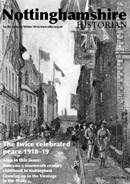
Notes on a nineteenth century childhood
Sam Kirk, who was born in Nottingham, emigrated to the USA in the 1880s, eventually settling in Richmond, Virginia. Jon M Stallard has edited Sam’s account of his early life.
The twice celebrated peace 1918–1919.
Most of us think the Great War ended in 1918 but, as Peter Fosterpoints out, the famous date of 11 November 1918 was the date of the Armistice which brought the fighting to an end. The official date for the end of the war was 28 June 1919, when the treaty of Versailles was signed.
Growing up in the Vicarage in the 1930s
Bernard Tinsley remembers the ten years he spent, between the ages of three and thirteen, in the vicarage of St Mary’s, Sutton in Ashfield.
Number 88: Spring/Summer 2012
 The leather industry in Nottingham with particular reference to Turney Brothers’ Leather Works, Trent Bridge
The leather industry in Nottingham with particular reference to Turney Brothers’ Leather Works, Trent Bridge
Denise Amos tells the story of how, in 1861, two brothers built a tannery and began to make leather on a site next to the River Trent and how their Leather Works was a landmark on entering or leaving Nottingham for over 100 years.
Commemoration of the 1817 Pentrich Rising
The Pentrich Rising was both part of a national movement for reform and a local uprising against the terrible conditions in this part of the country in 1817. Gwyneth Francis describes how it came about and what happened to those who took part.
The Nellie Greenhill Memorial Prize
Elizabeth Robinson recounts the story behind the prize, an interesting one that came about through caring families and the dedication of several women to the teaching of music in Nottingham.
Number 87: Autumn/Winter 2011
 Jeff Noble
Jeff Noble
Michael Jackson remembers an energetic and enthusiastic local historian.
Talking local history with Vernon Radcliffe
Robert Howard interviewed Vernon just before his death earlier this year when the talk was of museums, local history… and measuring rainfall.
Reflections on CLASP: the idea that will not go away
David Mackness writes on the modular building method pioneered by a consortium of local authorities, including those in Nottinghamshire, and which subsequently was responsible for buildings around the world. There is a list of documents which relate to the article.
Tackling village history
In the autumn of 2005 Norwell Parish Heritage Group was set up. Its aims were simple: to record the past and present heritage of Norwell Parish for the benefit of present and future generations and Elizabeth Jones describes how the villagers went about the task.
Architect & Soldier, A Man of Edwalton: Arthur Brewill DSO TD FRIBA
John Hall tells the story of a distinguished Nottingham architect who also served with great distinction as Commanding Officer of the Robin Hood Rifles in the First World War when in his mid-fifties.
Number 86: Spring/Summer 2011
 Sutton-in-Ashfield: The Unwin Dynasty and the Bag Hosiers
Sutton-in-Ashfield: The Unwin Dynasty and the Bag Hosiers
Professor Stanley Chapman tells the story of the Unwins, a dynasty of merchant hosiers, who dominated the local economy of Sutton-in-Asfield in the eighteenth century before being eclipsed in the nineteenth century by the bag hosiers of the town.
Homes fit for Heroes: Nottingham’s First Council Houses, 1919–1927
Lloyd-George’s rash promise during the 1918 election campaign, to build ‘a land fit for heroes’, including 500,000 houses, was partially fulfilled, in Nottingham at least, because of the enthusiasm with which the City Council began to build houses, as Peter Foster outlines in his article.
The centenary of the first cinemas in Nottingham
Michael Payne commemorates the opening of Nottingham’s first purpose-built cinemas by tracing their history, and that of their predecessors, the temporary cinemas which were an important part of Goose Fair at the end of the nineteenth century.
Number 85: Autumn/Winter 2010
 William Gladstone, MP for Newark
William Gladstone, MP for Newark
Ruth Sear writes about Gladstone’s early political career, when he was a Tory MP.
Thomas Stanley Roadley: The Flying Teacher
David Nunn writes about the Nottingham teacher who joined the Royal Flying Corps in 1916 and was killed in combat in 1917.
Interred in the chapel
Burial in nonconformist chapels wasn’t common in the East Midlands, but Philip E. Jones describes the lives of two men who shared the same name and who were buried in the chapels where they worshipped.
Newstead Abbey for sale
Ruth Sear describes Byron’s attempts to sell the house and estate which he inherited as a ten year old boy.
Number 84: Spring/Summer 2010
 Two Daves and the 1984 miners’ strike
Two Daves and the 1984 miners’ strike
Robert Howard writes about the reactions of two ex-miners to a new exhibition at the Galleries of Justice in Nottingham.
On the campaign trail Georgian style: the Newark by-election of 1829
Richard A Gaunt describes how the Duke of Newcastle’s favoured candidate was elected in an age before universal suffrage.
Nottingham and the great influenza pandemic of 1918–1919
Well over 1,000 citizens of Nottingham died in this deadly pandemic, and Peter Fostercharts its ebb and flow in the city, as told in local newspapers.
Matthew Clay
Christine Dabbs Clay tells the story of her ancestor, who rose from being humble Private Clay at the Battle of Waterloo to Sergeant Major Clay of the Bedfordshire Militia.
Number 83: Autumn/Winter 2009
 A New Map of Sherwood Forest
A New Map of Sherwood Forest
Alan MacCormick writes about the creation of a new map of Sherwood Forest, inspired by a late medieval map discovered in the collections at Belvoir Castle.
Did a Keyworth man meet Napoleon?
Howard Fisher wonders whether Thomas Church, who served as a soldier in the 53rd Foot in St Helena between 1815 and 1817, ever met the man he was guarding.
The Somme, Nottingham and the local press
Peter Foster tells the story of the Nottingham men who fell during the battle of the Somme and the difficulties which the local press had in trying to report what had happened.
Number 82: Spring/Summer 2009
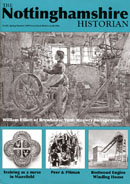 William Elliott of Brewhouse Yard (1701–1792): Hosiery Entrepreneur
William Elliott of Brewhouse Yard (1701–1792): Hosiery Entrepreneur
Professor Stanley Chapman describes the life and career of one of the most successful of eighteenth century hosiery entrepreneurs in the East Midlands, William Elliott of Brewhouse Yard, Nottingham.
SRN Training at Mansfield General and King’s Mill Hospitals, 1965–1968
Ruth Sear recounts the story of what she came to realise had been her excellent training at two mid-Nottinghamshire hospitals in the 1960s.
Peer and Pitman
Margaret Woodhead tells how the fourth Earl Manvers, Charles William Sydney Pierrepont, profited from the mining industry, while ensuring that he personally suffered no inconvenience from coal mining.
Number 81: Autumn/Winter 2008
 William Clark(e) 1843–1884 and Ann Tinley 1842–1927: their stories at Southwell, Halam and Doncaster Deaf & Dumb Institute
William Clark(e) 1843–1884 and Ann Tinley 1842–1927: their stories at Southwell, Halam and Doncaster Deaf & Dumb Institute
Derek H Wileman describes how research into the correspondence between the Poor Law Commissioners in London and the Southwell Union Guardians between 1834 and 1871 led him to trace the lives of two children, both with hearing impediments.
Fred Whiten 1868–1950: A Lovable Rogue?
Alan Malltratt tells the story of one of the less reputable members of his family.
Boots Booklovers Library 1898 to 1966
Ruth Sears traces the history of the private subscription library which was a feature of many Boots stores until the 1960s.
Number 80: Spring/Summer 2008
 Co-operative Societies in Greater Nottingham and their Journey into Politics
Co-operative Societies in Greater Nottingham and their Journey into Politics
Christopher Richardson recounts how ninety years ago the British Co-operative Movement took an historic decision to seek direct representation in Parliament and local government and how this affected the movement in greater Nottingham.
The Edwardian Gardens at Rufford
Philip Jones continues his story of the historic gardens at Rufford Abbey, this time tracing their development in the very early years of the twentieth century.
Two Brass Plaques
Maureen Newton describes how finding two brass plaques in Hucknall Central Methodist Church led to the discovery of the lost story of men who died in the First World War.
Chapel comes full circle
Kathy Powis tells the story of the Methodist chapel in Ruddington which has had a chequered career.
Number 79: Autumn/Winter 2007
 Wansley Hall and the Middletons: the final days
Wansley Hall and the Middletons: the final days
Clive Leivers examines the end of the 200 year period when the Middlenton family held the manor of Wansley.
The Victorian Gardens at Rufford
Philip Jones traces the history of the gardens at Rufford Abbey in the nineteenth century.
Robert Blincoe: Nottinghamshire’s Oliver Twist
Peter Hammond tells the story of the boy from London who was apprenticed to work in a cotton mill in Lowdham and the privations he suffered while he was there.
Number 78: Spring/Summer 2007
 Oliver Watts Hind: ‘A born leader and a man of vision’
Oliver Watts Hind: ‘A born leader and a man of vision’
John Hall tells the story of a Nottingham solicitor who was a leading figure in the Boys’ Brigade in the city.
Mapping Pre-enclosure Beeston, Nottinghamshire
Using eighteenth century documents and an early nineteenth century map, Geoffrey Drinkwater and Stephen Wallwork have traced early land holdings in Beeston.
The Villareal story
A monument in a local church and the unusual name of a local farm led Margaret Woodhead to uncover the story of a Portuguese woman of Jewish blood who married into the British aristocracy.
Number 77: Autumn/Winter 2006
 Cricket, Conjuring & the Co-operative Commonwealth: Aspiration at Stanford Hall
Cricket, Conjuring & the Co-operative Commonwealth: Aspiration at Stanford Hall
David Lazell traces the recent history of Stanford Hall, from being the home of a business magnate to becoming the Co-operative College.
Robert Lowe, Viscount Sherbrooke 1811–1892
Ruth Frear tells the story of a prominent nineteenth century Liberal politician who held most of the great offices of state.
Number 76: Spring/Summer 2006
 Sweated labour in the Nottingham lace industry
Sweated labour in the Nottingham lace industry
Stanley Chapman investigates the lives of the men, women and children who spent long hours in the factories of Nottingham’s lace industry.
Earthworks galore
Jeff Noble recalls the colliery spoil heaps which are now landscaped to such good effect.
Hanging, Drawing and Quartering: The King’s ‘Mercy’ and the 1817 Pentrich Rising
Dorothy Nikoll traces the story of the rising as told in little used documents held at The National Archives in Kew.
Number 75: Autumn/Winter 2005
 Free Churches and Nottingham beginnings
Free Churches and Nottingham beginnings
David Lazell describes the ‘bumpy ride’ which followed the agreement of a constitution for the free church movement in Nottingham in 1896.
George Fowler of Basford Hall
Neville Hoskins writes about the life of a prominent mining and civil engineer.
Some nineteenth century musical offerings in Nottingham
Michael Payne recalls a time when Nottingham’s music loving public enjoyed visits from Paganini and Liszt.
A shop remembered, 40 years on…
Alan Bailey reminiscences about his family’s retail business in Nottingham.
Number 74: Spring/Summer 2005
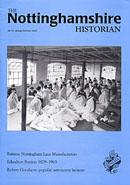 Birkins: the last of the Old Nottingham Lace Manufacturers
Birkins: the last of the Old Nottingham Lace Manufacturers
Stanley Chapman tells the story of the of the most successful lace manufacturer of his age, Richard Birkin, and the company he founded.
Edwalton Station 1 November 1879 to 1 November 1965
Denys Ridgway examines the life of a country station which originally served a village of fewer than 300 people but at its busiest served 10,000 passengers a year.
Robert Goodacre: popular astronomy lecturer
Madeline Cox describes how a Nottingham schoolteacher became a popular touring astronomy lecturer.
Number 73: Autumn/Winter 2004
 Charles Dickens in Nottingham
Charles Dickens in Nottingham
Michael Payne describes Charles Dickens’ four successful visits to Nottingham when he performed before enthusiastic and packed audiences.
Hymns and Lace: the life and works of John Newton
Clive Leivers tells the story of the lace maker and hymn writer whose music was, according to a contemporary report, ‘sung throughout length and breadth of England’.
Sir Horatio Davies
David Mellors follows the life and career of the last Lord of the Manor of West Bridgford who, although never resident on Nottinghamshire, was the source of several West Bridgford road names.
Number 72: Spring/Summer 2004
 Southwell Poor Law Union 1834-1871
Southwell Poor Law Union 1834-1871
Paul Carter gives a ‘work in progress’ report on a project to catalogue the correspondence of the Poor Law Union in Southwell.
James Flanagan: The story of a remarkable career
Peter Hammond describes the life and career of a renowned Primitive Methodist preacher and evangelist.
A Man of his Season: George Turnill 1913-1939
Robert Ilett tells the story of a Worksop man who fought in the Spanish Civil War.
The Wages of Sin
Alan Mallatratt presents a case study of a 19th century Mansfield prostitute.
Number 71: Autumn/Winter 2003
 The Museum of Nottingham Life at Brewhouse Yard
The Museum of Nottingham Life at Brewhouse Yard
Suella Postles describes the delight of this much loved museum.
Loyalism in Newark 1792-1795
Alan Dorling covers another aspect of Newark’s turbulent 18th century politics.
The Romance of Advertising
Jeff Noble explores the fascinating world of 19th century advertising.
Edith Ethel Ransom
Neville Hoskins tells the story of a remarkable Nottinghamshire woman remembered for her active life.
A Colliery and a Community
Mave Calvert tells how her community traced the history of the Warsop Colliery and the village of Warsop Vale.
Number 70: Spring/Summer 2003
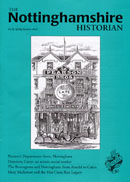 Pearson’s Department Store, Long Row, Nottingham
Pearson’s Department Store, Long Row, Nottingham
Nicholas Clark traces the history of this late, and much lamented, Nottingham institution.
Henrietta Carey: an artistic social worker
Terry Fry tells the story of a nineteenth century ‘one-woman social work department’.
The Boningtons and Nottingham: from Arnold to Calais
Stuart Burch follows Richard Parkes Bonington and his family from Nottingham to France, where his career as an artist began.
Mary Mallatratt and the Hot Cross Bun Legacy
Alan Mallatratt discovers the ill-feeling caused by the will of one of his ancestors.
Number 69: Autumn/Winter 2002
 Nottingham’s Health Pioneer: Philip Boobbyer, Medical Officer of Health for the City of Nottingham 1889-1929
Nottingham’s Health Pioneer: Philip Boobbyer, Medical Officer of Health for the City of Nottingham 1889-1929
Denise Amos pays tribute to the man who spent nearly forty years attempting to change public health conditions in Nottingham.
Early Roads and Footpaths in Beeston, Nottinghamshire
Geoffrey Drinkwater and Stephen Wallwork use an enclosure map of 1809 to explore these little studied routes.
Nottinghamshire’s SRN No.1
Neville Hoskins pays tribute to a Nottinghamshire woman, Ethel Bedford Fenwick, who campaigned for the state registration of Nurses.
Number 68: Spring/Summer 2002
 ‘One of the most efficacious, agreeable, useful and popular remedies of the day…
‘One of the most efficacious, agreeable, useful and popular remedies of the day…
Peter Hammond describes the life and work of another chemist from Nottingham.
Jacob John Astley
Neville Hoskins uncovers the mystery of a reference to a Nottinghamshire regiment, the Sherwood Foresters, in a Buckinghamshire church.
Nottingham’s Windmills
Helen Tilson traces the history of the windmills which were once such a feature of the landscape in Nottingham.
Number 67: Autumn/Winter 2001
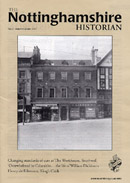 Changing standards of care for the sick at The Workhouse, Southwell
Changing standards of care for the sick at The Workhouse, Southwell
Susanna Smith from The National Trust tells a story of change and growing professionalism in the care of the sick in workhouses and later institutions.
‘Overwhelmed by Calamities…’: the turbulent life of William Dickinson, historian of Newark and Southwell
Adrian Henstock describes the life of a man who was involved in politics in Newark in the early 19th century as well as taking an interest in history.
Henry de Edenstou: King’s Clerk
Margaret Woodhead explains how a priest from Edwinstowe was taken into the king’s household as a clerk and eventually was able to build a chantry chapel in Edwinstowe’s church.
Number 66: Spring/Summer 2001
 The Tickhill Psalter
The Tickhill Psalter
In the second of two articles, John Fox continues the story of a beautifully illustrated mediaeval manuscript which was created in Nottinghamshire, but is now housed in the New York Public Library.
Growing up near Warsop Main Colliery
Jeff Noble describes growing up living in a stone terraced house next to the sidings of the colliery, where his father was underground engineer.
The life and labours of Richard Rawlins
Ian Mathews tells the story of the man who was perpetual curate at St Helens, Kneeton in Nottinghamshire for 31 years.
Number 65: Autumn/Winter 2000
 The Tickhill Psalter
The Tickhill Psalter
In the first of two articles, John Fox tells the story of a beautifully illustrated mediaeval manuscript which was created in Nottinghamshire, but is now housed in the New York Public Library.
A Pinder’s Tale
Clive Leivers describes how a minor official’s involvement in enclosure in late 19th century Selston led to him being involved in rioting.
Number 64: Spring/Summer 2000
 Gone for a Burton
Gone for a Burton
Valerie Henstock traces the rise and fall of a once-famous Nottingham landmark, the ‘Harrods food-hall’ of the city.
A Friend of Liberty: The Newark printer Daniel Holt
Alan Dorling tells the story of one man’s part in the turbulent years at the end of the eighteenth century.
Francis Wheatley VC: A Forgotten Hero
Philip Jones reclaims a lost hero from Ruddington.
Number 63: Autumn/Winter 1999
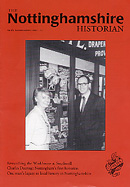 Workhouse Detectives
Workhouse Detectives
In the second article in her series, Susanna Smith of the National Trust describes some of the research that has been taking place as part of the project to restore The Workhouse, Southwell.
Dr Charles Deering: Nottingham’s first historian
John Becket and Cathy Smith reflect on the first history of Nottingham, published nearly 250 years ago, and on the life of its author.
On the cards: one man’s legacy to local history in Nottinghamshire
Stephen Best describes the work of William Doubleday who bequeathed to the city his collection of 300,000 index cards on its local history.







This issue is full of topical news and articles. The Events Diary is really useful. Keep up the good work
Hello Historians,
I am researching my convict ancestor who was tried in the Nottingham Assizes in 1844. Can anyone suggest where or how I could obtain Trial details from March 1844 or reports for the crime of Highway Robbery committed in Tuxford In January 1844. The name of the accused was John Brumby born in Tuxford in 1822.
Hello Gwen
Try Nottinghamshire Archives or have a look at the University of Nottingham web page for historic newspapershttps://www.nottingham.ac.uk/studyingeffectively/reading/findingresources/otherresources/newspapers/index.aspx#historical
Regards
John Parker
Pingback: January Sale – Triskele Publishing
Pingback: Final Sale – A Palace For Our Kings – Triskele Publishing
Hello guys I’m 16 and I would like to become a historian possibly. I was wandering if being a historian is an adequate career choice or should it be a part-time/hobby. If I could get some advice on how to become a historian it would be greatly appreciated.
Hello Daniel, I don’t know where you live but here in Nottingham we have a network of both local and county based groups as well as a good local studies library and a good County Archives service, any of these would be a good starting point for you to get a ‘feel’ for local history. You might also try having a look at the website for the British Association for Local History (BALH) at http://www.balh.org.uk; contact your local university and see what courses they are offering in history; read ‘In Defence of History’ by Richard J Evans (or something like that, your local library will point you in the right direction); you are always welcome to attend the Nottinghamshire Local History Association Day School on 24th March 2018.
Regards
John Parker
How can I get a copy of the article from Nottingham Historian No 76 Spring/Summer 2006 by Stanley Chapman called sweated labour in Nottingham Lace Industry. I am an OU student writing an essay.
Hi is it possible to get a copy of an article in a back issue of The Nottingham Historian? I would like to read the article in Spring /Summer 2004 regarding Reverend James Flanagan as he is a relative of mine
I don’t think we have any that far back….